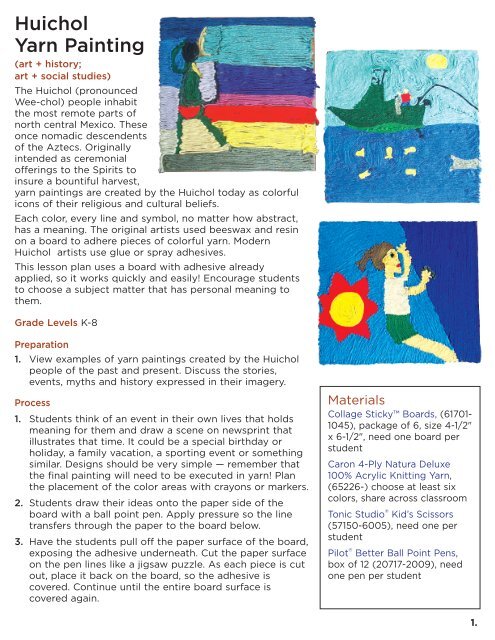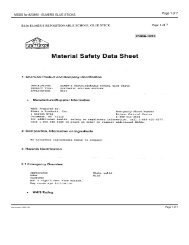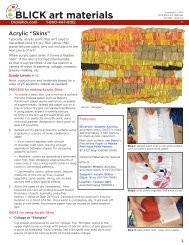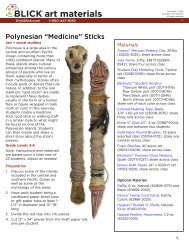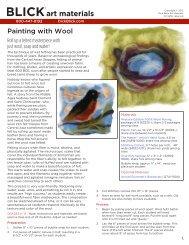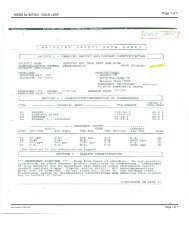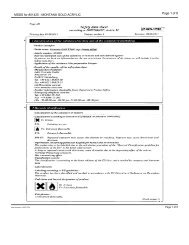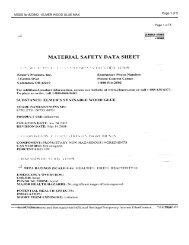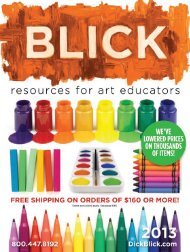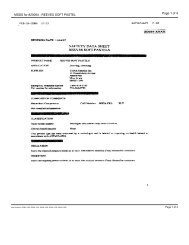Huichol Yarn Painting - Dick Blick - Dick Blick Art Materials
Huichol Yarn Painting - Dick Blick - Dick Blick Art Materials
Huichol Yarn Painting - Dick Blick - Dick Blick Art Materials
You also want an ePaper? Increase the reach of your titles
YUMPU automatically turns print PDFs into web optimized ePapers that Google loves.
<strong>Huichol</strong><br />
<strong>Yarn</strong> <strong>Painting</strong><br />
(art + history;<br />
art + social studies)<br />
The <strong>Huichol</strong> (pronounced<br />
Wee-chol) people inhabit<br />
the most remote parts of<br />
north central Mexico. These<br />
once nomadic descendents<br />
of the Aztecs. Originally<br />
intended as ceremonial<br />
offerings to the Spirits to<br />
insure a bountiful harvest,<br />
yarn paintings are created by the <strong>Huichol</strong> today as colorful<br />
icons of their religious and cultural beliefs.<br />
Each color, every line and symbol, no matter how abstract,<br />
has a meaning. The original artists used beeswax and resin<br />
on a board to adhere pieces of colorful yarn. Modern<br />
<strong>Huichol</strong> artists use glue or spray adhesives.<br />
This lesson plan uses a board with adhesive already<br />
applied, so it works quickly and easily! Encourage students<br />
to choose a subject matter that has personal meaning to<br />
them.<br />
Grade Levels K-8<br />
Preparation<br />
1. View examples of yarn paintings created by the <strong>Huichol</strong><br />
people of the past and present. Discuss the stories,<br />
events, myths and history expressed in their imagery.<br />
Process<br />
1. Students think of an event in their own lives that holds<br />
meaning for them and draw a scene on newsprint that<br />
illustrates that time. It could be a special birthday or<br />
holiday, a family vacation, a sporting event or something<br />
similar. Designs should be very simple — remember that<br />
the final painting will need to be executed in yarn! Plan<br />
the placement of the color areas with crayons or markers.<br />
2. Students draw their ideas onto the paper side of the<br />
board with a ball point pen. Apply pressure so the line<br />
transfers through the paper to the board below.<br />
3. Have the students pull off the paper surface of the board,<br />
exposing the adhesive underneath. Cut the paper surface<br />
on the pen lines like a jigsaw puzzle. As each piece is cut<br />
out, place it back on the board, so the adhesive is<br />
covered. Continue until the entire board surface is<br />
covered again.<br />
<strong>Materials</strong><br />
Collage Sticky Boards, (61701-<br />
1045), package of 6, size 4-1/2"<br />
x 6-1/2", need one board per<br />
student<br />
Caron 4-Ply Natura Deluxe<br />
100% Acrylic Knitting <strong>Yarn</strong>,<br />
(65226-) choose at least six<br />
colors, share across classroom<br />
Tonic Studio ® Kid’s Scissors<br />
(57150-6005), need one per<br />
student<br />
Pilot ® Better Ball Point Pens,<br />
box of 12 (20717-2009), need<br />
one pen per student<br />
1.
Process, continued<br />
(This will prevent yarn from sticking in<br />
areas it’s not supposed to, and adhesive<br />
from loosing it’s tackiness).<br />
4. Cut a piece of yarn about 12" long. Start<br />
anywhere on the board, pull up one of<br />
the pieces of surface paper and lightly lay<br />
down the yarn, following the shape of the<br />
design. Press it firmly into place and trim<br />
off the excess with scissors.<br />
Peel off the next piece and continue to<br />
apply the yarn one area at a time until<br />
the board is filled with color.<br />
National Standards<br />
Content Standard #1 — Understanding and applying<br />
media, techniques, and processes<br />
K-4 Students use different media, techniques, and<br />
processes to communicate ideas, experiences, and<br />
stories<br />
5-8 Students intentionally take advantage of the qualities<br />
and characteristics of art media, techniques, and<br />
processes to enhance communication of their experiences<br />
and ideas<br />
Content Standard #3 — Choosing and evaluating a<br />
range of subject matter, symbols, and ideas<br />
K-4 Students select and use subject matter, symbols,<br />
and ideas to communicate meaning<br />
5-8 Students integrate visual, spatial, and temporal<br />
concepts with content to communicate intended meaning<br />
in their artworks<br />
Content Standard #4 — Understanding the visual arts in<br />
relation to history and cultures<br />
K-4 Students know that the visual arts have both a<br />
history and specific relationships to various cultures<br />
5-8 Students know and compare the characteristics of<br />
artworks in various eras and cultures<br />
Options<br />
- Use white glue on cardboard instead of<br />
the self-adhesive board and spread<br />
evenly on one area at a time<br />
- Apply to a 3-D object, such as a box,<br />
using the glue technique (see photo,<br />
above)<br />
- Instead of glue, try double-stick tape<br />
Lesson Plan Idea and <strong>Art</strong>work submitted by<br />
submitted by Todd Johnson, Knoxville, TN<br />
Copyright © 2004 <strong>Dick</strong> <strong>Blick</strong> <strong>Art</strong> <strong>Materials</strong>. All rights reserved.<br />
2.


